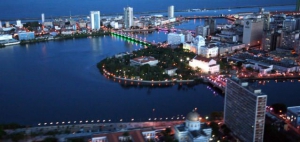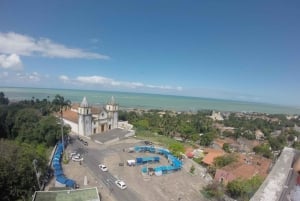History of Pernambuco
Brazil was officially discovered by the Portuguese sailor Pedro Álvares Cabral, en route to India. His fleet arrived in 1500 where today is the State of Bahia, though accounts of earlier discoveries by European navigators include Cabo de Santo Agostinho, south of Recife, and even shipwrecked sailors on Itamaracá Island in Pernambuco.
As Portugal had more profitable business to attend in Asia, Brazil's colonization was not a State priority, until the invasions by other European powers became a growing problem. The French pirates, for instance, paid constant visit to the land in search of the Brazilwood - a tree much appreciated by the textile industry and whence Brazil got its name.
The crown's solution to occupy Brazil's vast land was to split it into 15 hereditary captaincies, given to Portuguese noblemen in exchange for duties on the trading of timber, sugar and gold.
The first captaincy of Pernambuco was taken up in 1535 by Duarte Coelho, who built the small village of Santa Cruz, modern day Igarassu, on the North Coast of Pernambuco, though he found heavy resistance by the Caetés Indians. The São Cosme e Damião church located there (and still open to visitors) was built in 1535 in gratitude for his victory against natives, being thus the first church constructed in Brazil.
A couple of years later, the capital of the captaincy was established in Olinda, founded on March 12, 1537, under the exclamation "Oh, linda situação para uma vila!" ("Oh, what a beautiful site for a village!"), as tradition says. Immediately to the south, a small fishermen village was named "Recife", due to the reefs on the coast which formed a naturla harbour.
By the end of the 16th century, Pernambuco was the only economically successful captaincy, followed by São Vicente (modern-day São Paulo), due notably to its prosperous sugarcane cultivation. Olinda, Pernambuco's capital, already had Jesuit schools and a hospital (Casa de Misericórdia). By 1580, Pernambuco was the world's leading sugar producer, while the Dutch (which entertained amicable relations with Portugal) processed and distributed it across Europe. This sweet business turned sour when Spain (which didn't think as highly of the Dutch) took over the Portuguese crown and closed Brazilian harbours to the Netherlands.
In order to overcome this situation, the Dutch did what any modern-day venture capitalist does when negotiations get stale: a hostile takeover. The West India Company was founded in the Netherlands in 1621 and sent several expeditions to the Brazilian Northeast coast to regain control of its "offshore investment".
After a frustrated attempt in Bahia in 1625, the Dutch managed to invade Pernambuco five years after. The Dutch fleet had to deploy in Pau Amarelo, since Recife's port was blocked. Olinda was burned to the ground, as the Dutch deemed it vulnerable and chose Recife to be the capital instead, due to its natural port.
The initial years under Dutch rule were repressive, but that changed with the arrival of Maurice of Nassau, a mix of progressive administrator and Renaissance man who knew just how to win the hearts and minds of the locals: proclaiming religious freedom, carrying out important public works and lowering interest rates.
With religious freedom, a pioneer Jewish community established itself in Recife and built the first synagogue of the Americas. Under Nassau's seven year rule, Recife became the cosmopolitan "Mauritsstad", the capital of Dutch Brazil and of the West India Company's empire. It was the first city in the Americas to undergo urban planning. Foreign architects, engineers, artists and scientists were called to built the new town. Among Nassau's buildings: palaces, bridges (including one named after him, still there in the Capibaribe River), fortresses (the "Forte das 5 Pontas" or Fort of the 5 Points, rebuilt one point short and now the Museum of the City of Recife, and the Orange Fortress in Itamaracá) and many more. The Instituto Ricardo Brennand has an admirable collection of paintings and artefacts from that period.
Nassau's embellishment of Recife, however, brought little return to the West India Company's bottom line. So, when Nassau was called back to Europe in 1644, Amsterdam became stricter with Pernambuco in order to recover its investment. Debts were called, interest rates went up, along with general dissatisfaction, which led to a series of uprisings that started in 1645 but only ended in 1654, when the Dutch finnally signed their surrender. The most important uprising was "the Battle of Guararapes" (1648 and 1649, the final one) in which locals (Pernambucanos) led by the sugarcane landlords, João Fernandes Vieira e André Vidal de Negreiros, and under the command of the portuguese general Francisco Barreto de Menezes beated the foreign armies. The Monte dos Guararapes, in Jaboatão dos Guararapes (a neighbouring city in the metropolitan region of Recife), was the stage of the final struggle. A chapel was built in celebration, today replaced by the Nossa Senhora dos Prazeres church in the 18th century, which is open to visits. This victory against the Dutch made Brazil really believed of being a Nation .
Many of Dutch constructions were destroyed by the Portuguese. Their most enduring legacies, however, can still be seen today on the eyes and tongue of the people of Pernambuco: the state's drylands are full of green-eyed descendants, while the characteristic accent spoken all over Pernambuco (which stresses the R sounds) echoes this Flemish past.
Ironically, despite their defeat, the Netherlands remained on the winning side: they started to grow sugar at lower prices in the Antilles, thus bankrupting Pernambuco's economy, while the Jews (no longer welcome in the Catholic colony) sailed on to New Amsterdam, where a city called New York came to be. With the decline of sugarcane cultivation, the colony's economic centre shifted towards Minas Gerais, where gold and precious stones mining had begun, and, lastly, to São Paulo and its coffee cultivation.
For the rest of its colonial history, Pernambuco became a stage for rebellions and uprisings, for varied reasons and with all sorts of characters. First it was the merchants, in a 1710 dispute between Olinda and Recife, because the latter came to surpass the former in economic significance and demanded political autonomy.
Afterwards, in 1817, it was the priests, for Brazil's independence from Portugal and instauration of a Republic. The conspiring clerics were hanged, except for one "Frei Caneca" who managed to get away and reattempt the revolution seven years later (though it failed again and this time he got executed at the 5-point Fortress).
Lastly, along came the liberal politicians, in 1848, who rebelled against central government. As a result of such continuous revolt against central authority, Pernambuco had portions of its territory subtracted to create the tiny States of Alagoas and Sergipe, to its south. In spite of having its territory shrunk, Pernambuco left a big mark on Brazil's history.
Pernambuco also played an important role in favour of the Slavery Abolition, which only happened on 13 May 1888. Many of its intelectuals fought against slavery, but Joaquim Nabuco stood out. He came from a rich background, his family had an important sugar mill that had slaves working there. He was very fond of the slaves as a child and could not bear seeing their suffering. He studied Law and became a Deputy for Pernambuco. That is when he started his fight to free the slaves. He wrote an important book "O Abolicionismo" .when he was in London in 1883. He was a politician, a diplomat, a writer and a speaker. His famous speech against Slavery at the magnificent Teatro de Santa Isabel definetely made him be part of the Brazilian History. The 'Fundação Joaquim Nabuco" is an institute in Recife that preserves his historical and cultural legacy and is also dedicated to the history of Brazil. You can also visit the sugar mill where he spend his childhood "Engenho Massangana".
Throughout economic ups and downs, Pernambuco has remained a key regional and national player, and a regional hub for commerce and services.
In the dawn of the 21st century, the State quickly regained its national significance, being today one of the most puissant and fastest-growing economies of the country. The metropolitan region of its capital, Recife, is the largest in North and Northeast Brazil and has world class facilities for healthcare, shopping, airport, cruise terminal and many more.
The State has attracted multi-billion dollar investments from the petrochemical, maritime and manufacturing industries, due to the industrial port complex of Suape and other industrial sites; as well as high technology, with the Porto Digital being a national example for entrepreneurship and innovation in the digital era, and hosting from 2012 on an edition of the well-known technology fair, Campus Party. Pernambuco has truly entered the globalised economy.
This success has led a boom in civil construction, both residential and commercial, including a number of new and refurbished hotels and luxury residential condominiums such as Reserva do Paiva and Alphaville (further real estate investment opportunities can be found in the Property section of this guide).
Pernambuco is among the hosts that will receive the FIFA's 2013 Confederation Cup and 2014 World Cup matches, which has led to mega investments in sports and transportation infrastructure. The "Arena Pernambuco", a state-of-the-art, purpose-built stadium with 46.105 seats, is being built in the city of São Lourenço da Mata (30 min away from downtown Recife) along with an entirely new planned district, the "Cidade da Copa", which will comprise residential areas, hotels and university campus.
On top of all that, it is still preserves the natural beauties, such as its beaches, and cultural traditions, embodied in its handicraft, music and dance, which remain unchanged with the march of time.
* Photos by Hugo Acioly (EMPETUR) and Evaldo Parreira















